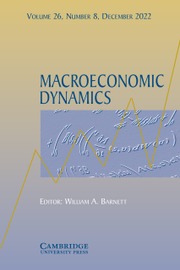Article contents
How do economic growth and food inflation affect food insecurity?
Published online by Cambridge University Press: 27 August 2025
Abstract
During the global recession of 2020 food insecurity increased substantially in many countries around the world. Fortunately, the surge in food insecurity quickly came to a halt as the world economy returned to its positive growth path, despite double-digit domestic food inflation in most countries. To shed light on the relative importance of income growth and food inflation in driving food insecurity, we employ a heterogeneous-agent model with income inequality, complemented by novel cross-country data for the period 2001–2021. We use external instruments (changes in commodity terms-of-trade, external economic growth, and harvest shocks) to isolate exogenous variation in domestic income growth and food inflation. Our findings suggest that income growth is the dominant driver of annual variations in food insecurity, while food price inflation plays a somewhat smaller role, aligning with our model predictions.
Information
- Type
- Articles
- Information
- Copyright
- © The Author(s), 2025. Published by Cambridge University Press
References
- 1
- Cited by

